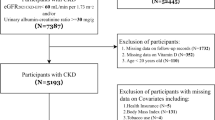Abstract
Purpose
Cranberry supplements are commonly used as a natural deterrent to urinary tract infection. However, one small study (n = 5) which showed an increase in urinary oxalate levels following cranberry supplementation has led to its use with caution among patients susceptible to nephrolithiasis. Furthermore, most commonly available cranberry tablet preparations contain vitamin C, which has been independently shown to increase urinary oxalate excretion. The aim of this study is to investigate the influence of cranberry supplementation on urinary oxalate excretion.
Methods
Fifteen participants were randomised to receive cranberry tablets alone or cranberry tablets containing vitamin C. Tablets were taken at the manufacturers recommended dosage for a period of 14 days. Participants provided a 24 h urine collection at trial entry and day 14. Urinary variables were compared to assess for changes in oxalate levels.
Results
The median age was 27 years (21–43). There was no difference in the 24 h urine volume pre or post commencement of cranberry tablets (1.7 vs 2 L, p = 0.07). An increase in median urinary oxalate excretion was observed in participants taking both cranberry-only tablets (0.10 mmol/day) and tablets containing vitamin C (1.15 mmol/day).
Conclusion
Dietary supplementation with cranberry increases urinary oxalate excretion and should be avoided in patients at risk of urolithiasis.



Similar content being viewed by others
References
Hutchens AR (1992) A handbook of Native American herbs. Shambhala Publications
Kinney AB, Blout M (1979) Effect of cranberry juice on urinary pH. Nurs Res 28:287–290
Howell AB, Vorsa N, Marderosian AD, Foo LY (1998) Inhibition of the adherence of P-fimbriated E. coli to uroepithelial surfaces by proanthocyanidin extracts from cranberries. N Engl J Med 339:1085–1086
Avorn J, Monane M, Gurwitz JH, Glynn RJ, Choodnovskiy I, Lipsitz LA (1994) Reduction of bacteria and pyuria after ingestion of cranberry juice. JAMA 271:751–754
Luís Â, Domingues F, Pereira L (2017) Can cranberries contribute to reduce the incidence of urinary tract infections? A systematic review with meta-analysis and trial sequential analysis of clinical trials. J Urol 198(3):614–621
Baxmann AC, De OG, Mendonca C, Heilberg IP (2003) Effect of vitamin C supplements on urinary oxalate and pH in calcium stone-forming patients. Kidney Int 63(3):1066–1071
Levine M, Conry-Cantilena C, Wang Y et al (1996) Vitamin C pharmacokinetics in healthy volunteers: evidence for a recommended dietary allowance. Proc Natl Acad Sci USA 93:3704–3709
Tiselius HG, Almgard LE (1977) The diurnal urinary excretion of oxalate and the effect of pyridoxine and ascorbate on oxalate excretion. Eur Urol 3:41–46
Chalmers A, Cowley D, Brown J (1986) A possible etiological role for ascorbate in calculi formation. Clin Chem 32:333–336
Urivetzky M, Kessaris D, Smith AD (1992) Ascorbic acid overdosing: a risk factor for calcium oxalate nephrolithiasis. J Urol 149:1215–1218
Pearle MS (2003) Effect of vitamin C supplements on urinary oxalate and pH in calcium stone-forming patients. Int Braz J Urol 29(2):167
Feres MC, Bini R, De Martino MC, Biagini SP, de Sousa AL, Campana PG, Tufik S (2011) Implications for the use of acid preservatives in 24-hour urine for measurements of high demand biochemical analytes in clinical laboratories. Clin Chim Acta 412(23–24):2322–2325
Tiselius HG (1991) Aspects on estimation of the risk of calcium oxalate crystallization in urine. Urol Int 47(4):255–259
Ramello A, Vitale C, Marangella M (2001) Epidemiology of nephrolithiasis. J Nephrol 13:S45–S50
Lewandowski S, Rodgers AL (2004) Idiopathic calcium oxalate urolithiasis: risk factors and conservative treatment. Clin Chim Acta 345:17–34
Rodgers A (1999) Aspects of calcium oxalate crystallization: theory, in vitro studies, and in vivo implementation. J Am Soc Nephrol 14:351–354
Laminski NA, Meyers AM, Kruger M, Sonnekus MI, Margolius LP (1991) Hyperoxaluria in patients with recurrent calcium oxalate calculi: dietary and other risk factors. Br J Urol 68(5):454–458
McHarg T, Rodgers A, Charlton K (2003) Influence of cranberry juice on the urinary risk factors for calcium oxalate kidney stone formation. BJU Int 92(7):765–768
Terris MK, Issa MM, Tacker JR (2001) Dietary supplementation with cranberry concentrate tablets may increase the risk of nephrolithiasis. Urology. 57(1):26–29
Gettman MT, Ogan K, Brinkley LJ, Adams-Huet B, Pak CY, Pearle MS (2005) Effect of cranberry juice consumption on urinary stone risk factors. J Urol 174(2):590–594
White BL, Howard LR, Prior RL (2011) Impact of different stages of juice processing on the anthocyanin, flavonol, and procyanidin contents of cranberries. J Agric Food Chem 59(9):4692–4698
The Food Processor, Version 10.12.0, ESHA Research, Salem, Oregon, USA
Kessler T, Jansen B, Hesse A (2002) Effect of blackcurrant-, cranberry-and plum juice consumption on risk factors associated with kidney stone formation. Eur J Clin Nutr 56(10):1020
Author information
Authors and Affiliations
Contributions
REJ: data collection, data analysis, manuscript writing/editing. MCF: data collection, manuscript writing/editing. LJ: data collection. FK: data collection. AS: data analysis. CV: data analysis. LTH: manuscript writing/editing. MRP: protocol/project development, manuscript writing/editing.
Corresponding author
Ethics declarations
Conflict of interest
None.
Statement of human rights
All procedures performed in studies involving human participants were in accordance with the ethical standards of the institutional and/or national research committee and with the 1964 Helsinki Declaration and its later amendments or comparable ethical standards.
Informed consent
Informed consent was obtained from all individual participants included in the study.
Rights and permissions
About this article
Cite this article
Redmond, E.J., Murphy, C.F., Leonard, J. et al. The influence of dietary supplementation with cranberry tablets on the urinary risk factors for nephrolithiasis. World J Urol 37, 561–566 (2019). https://doi.org/10.1007/s00345-018-2344-1
Received:
Accepted:
Published:
Issue Date:
DOI: https://doi.org/10.1007/s00345-018-2344-1




